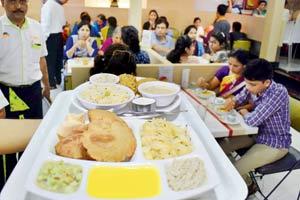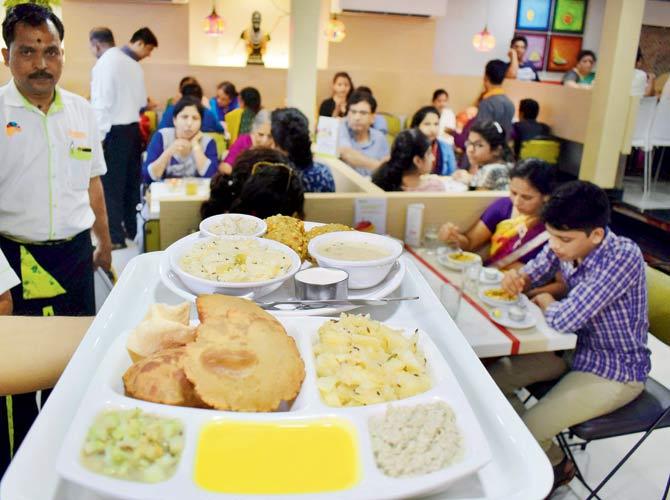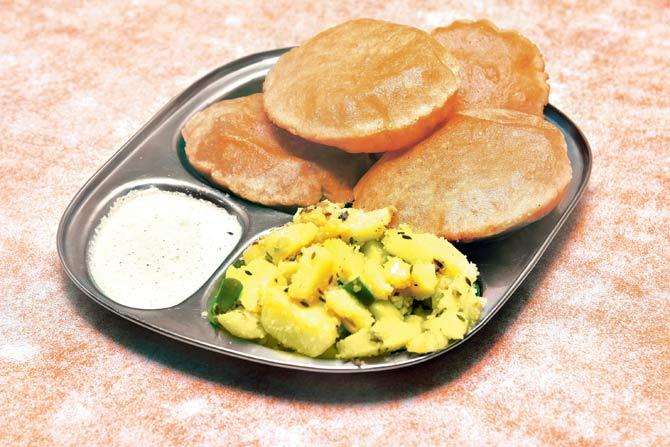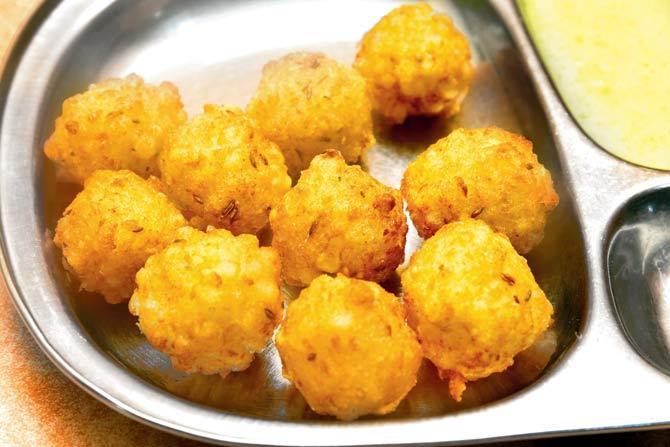How ritual fasting across India has become as much about indulgence, as it is about abstinence


Aaswad at Dadar and Kolhapuri Chivda at Girgaum boast of a special farali 'fast' menu
ADVERTISEMENT
 Karti hu tumhara vrat main, sweekar karo Maa, mazhdaar mein main atki, beda paar karo Maa. The Usha Mangeshkar number had a profound impact on my eight-year-old mind, when I watched Jai Santoshi Maa in the old-style Yadav Talkies in Gwalior in June 1975. The movie, deemed the right fit for the family's vacationing school-goers, introduced me to the world of ritual fasting in which the suffering heroine, Satyavati, successfully abstained from normal food pleasures for 16 consecutive Fridays. Her frail self is saved in that period by Goddess Santoshi from a series of obstacles - the most intriguing being her slave-driving cruel sisters-in-law. They squeeze lime juice on the prasad in an attempt to break Satyavati's vow, knowing that the Goddess disapproves of all things sour. The Devi's punishment to the mischievous citrus-conspirators and her blessings showered on Satyavati remain permanently etched in my memory; so, is the equation of ritual fasts with self-denying pious behaviour.
Karti hu tumhara vrat main, sweekar karo Maa, mazhdaar mein main atki, beda paar karo Maa. The Usha Mangeshkar number had a profound impact on my eight-year-old mind, when I watched Jai Santoshi Maa in the old-style Yadav Talkies in Gwalior in June 1975. The movie, deemed the right fit for the family's vacationing school-goers, introduced me to the world of ritual fasting in which the suffering heroine, Satyavati, successfully abstained from normal food pleasures for 16 consecutive Fridays. Her frail self is saved in that period by Goddess Santoshi from a series of obstacles - the most intriguing being her slave-driving cruel sisters-in-law. They squeeze lime juice on the prasad in an attempt to break Satyavati's vow, knowing that the Goddess disapproves of all things sour. The Devi's punishment to the mischievous citrus-conspirators and her blessings showered on Satyavati remain permanently etched in my memory; so, is the equation of ritual fasts with self-denying pious behaviour.

Comprising Rajgira puri-bhaji
Ever since, the forbidden nimbu reminds me of the divergent dos and don'ts applicable to Indian fasts across regions and faiths, principally in the context of people around me, who fast for religious or personal reasons. My cook was advised by the doctor not to continue with her fasts of long durations - Shravan Mondays and nine days of Navratri - after her heart condition. She has followed the advice only half-way. My mother-in-law, who said she will discard the annual calendar of fasts after the Kashi pilgrimage, has gone back on the promise. Then, there are friends, who like to eat food prepared for those who fast, and take recourse to antacid tablets after they feast over sabudana wadas on Ekadashi, Chaturthi or similar grand fast days. A Girgaum friend doesn't have a cook on the Ganesh Chaturthi days, but makes it a point to visit the 93-year-old Kolhapuri Chivda joint that serves the rajgira puri-bhaji delicacy.

Sabudana wadas. Pic/Ashish Raje, Atul Kamble
A friend in Pune travels a long distance to eat the "upvas thali" on Ekadashi days at Baadshahi dining, for which he doesn't mind queuing up for over an hour. Mumbai's Aaswad eatery also prides on the first-of-its kind "farali" - faral implies food eaten during fasts - thali menu, which is overbooked on crucial days. Interestingly, Soam's farali thali, served in the month of Shravan, is not for those who are fasting; considering it has several fun items like fried munchies that don't strictly adhere to "fast" restrictions. A friend in Ahmedabad was pleasantly surprised to be treated to a Shravan thali in a hospital, while he was being treated for jaundice.
Some of the annual fasts like the one on Mahashivratri - in the honor of Lord Shiva - sets the 'fast' food industry in super-active mode. The menu laden with fruits, potatoes - mostly sweet potatoes, rock salt, milk, sago, water chestnut flour or buckwheat flour - meant for the devotees of Lord Shiva - has gone universal. A manifestation of that was witnessed at a recent wedding reception in Pune, which coincided with Mahashivratri. The host, Pune's former mayor Dr Satish Desai, treated around 5,000 guests to a Mahashivratri platter comprising 25 "fast-appropriate" items, some of which were more unique than the usual - ratali chaat, kavath chutney (made of wood apple), ladoos made of date-cashew and rajgira puri. His caterer, Sriram Bhave, the owner of Pune's Wadeshwar food joint, thereafter earned a "fast-special" tag, although he has not been able to extend the template to other fasts like Ganesh Chaturthi or Rishi Panchami. The latter is exclusively an all-women fast to pay obeisance to the Seven Sages - seven patriarchs of the Vedic religion - and requires an abundance of a special mix vegetable including, colocasia roots and leaves, pumpkin and ridge gourd. Few eateries attempt the culinary mix.
Incidentally, there are neighbourhoods, where the Mahashivratri day is a "deliberate" full-meal occasion for Vaishnav bhakts, who savour varan (a toor dal preparation tempered with spices) and puran (ground chana dal, jaggery, cardamom nutmeg powder and ghee) grandly. At a Bengali friend's set up, Shivratri fast may end by noon with milk, fruits, sago and coconut and can be followed by a puri-potato sabzi combo in the evening.
I have also wondered about the myriad ways in which the Upvas fare is spiced up and made attractive in general, very often contradicting the core sentiment of eating less during fasts. The wide assortment of upvasache kebab, upvas idli dosa, vrat ke dahi vade or singhade ki namkeen barfi seems dizzying. Likewise, the westernisation of upvas items - farali pizza, farali frankie - is a tad over-the-top, as if the domestic choices aren't enough.
Food scholars and sociologists approach fasts in an academic light. They feel fasts serve a "switch on-off" purpose in a fast-paced urban life, where religious sanction helps break the food monotony. The practice of fasting universally admits concession and partial allowance for selected types of food. Among Christians, Friday was fasting day and most meats were disallowed. But, there was concession for fish, and from there sprung the phrases like fish for Friday.
The domination of carbohydrates in most fasts is of course obvious, as they offer immediate calorie uptake, as well as a sense of "belly fullness". In this context, the intake of sago, potato and groundnut in upvas items has raised concern amongst nutritionists. Many doctors advise for replacement of sago (especially the high-calorie fattening fried sabudana) with wari (bhagar in some places) and water chestnuts.
Pune-based Dr Pradeep Apte, who has studied tabooed and allowed foods, feels there is little logic to what is prescribed (or not) during fasts and many a times, the availability rules the moment. He informs that groundnut replaced sesame as a general use ingredient in the last century, although sesame at one point had the "auspicious" tag. But, groundnut won because of greater yield and higher oil recovery. Of late groundnut, sago and potato have risen in upvas stature. Interestingly, sago and potato are not even traditional items - potato was introduced by the Portuguese in the 17th century and proved to be a higher yield crop than sweet potatoes. Sago is around 135 years old, and its mass acceptance in the upvas segment is contemporary.
Meanwhile, the Santoshi Maa fast doesn't seem to be in vogue these days, as newer fasts have entered public consciousness. The Vaibhav Lakshmi Vrat now has a wider clientele, which involves men and women fasting for 11 or 21 Fridays, ending their commitment with a small-scale ceremony. Fasting on seven Saturdays for the Shani God has also taken precedence in the intervening years. The Tuesday fasting for Ganpati came in vogue only two decades ago, after celebrities started their barefoot walk to Mumbai's Siddhivinayak temple. Similarly, the Karva Chauth sunrise-to-moonrise fast done by women for the safety and longevity of their husbands was once restricted to North India. Thanks to Bollywood, women in Maharashtrian homes also fast on this day - they await the rise of the moon to be seen through the customary sieve. It is just that Mumbai's crowded skyline makes the moon a bit elusive.
Also Read: Fasting And Feasting In Mumbai
Sumedha Raikar-Mhatre is a culture columnist in search of the sub-text. You can reach her at sumedha.raikar@gmail.com
Catch up on all the latest Mumbai news, crime news, current affairs, and also a complete guide on Mumbai from food to things to do and events across the city here. Also download the new mid-day Android and iOS apps to get latest updates
 Subscribe today by clicking the link and stay updated with the latest news!" Click here!
Subscribe today by clicking the link and stay updated with the latest news!" Click here!






